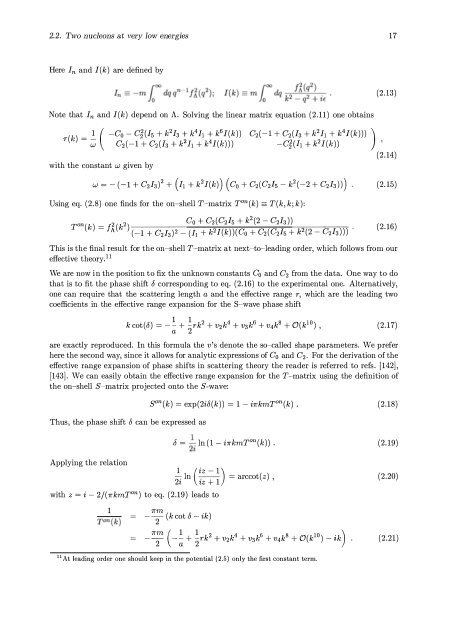The Nucleon-Nucleon Interaction in a Chiral Effective Field Theory
The Nucleon-Nucleon Interaction in a Chiral Effective Field Theory
The Nucleon-Nucleon Interaction in a Chiral Effective Field Theory
You also want an ePaper? Increase the reach of your titles
YUMPU automatically turns print PDFs into web optimized ePapers that Google loves.
2.2. Two nucleons at very low energies<br />
Here In and I(k) are def<strong>in</strong>ed by<br />
Note that In and I(k) depend on A. Solv<strong>in</strong>g the l<strong>in</strong>ear matrix equation (2.11) one obta<strong>in</strong>s<br />
r (k) = � ( -Co - Ci(h + k 2 h t k 4 h � k 6 I(k)) C2( -1 + C2(h + k 2 h + k4 I(k))) )<br />
w C2( -1 + C2(h + k h + k I(k))) -Ci(h + k 2 I(k))<br />
with the constant w given by<br />
w = - (-1<br />
+ C2h) 2 + (h + k 2 I(k)) (Co + C2(C2h - k 2 (-2 + C2h)))<br />
Us<strong>in</strong>g eq. (2.8) one f<strong>in</strong>ds for the on-shell T-matrix Ton(k) == T(k, k; k):<br />
Ton (k) = fÄ (k 2 )<br />
Co + C2(C2h + k 2 (2 - C2h))<br />
(-1 + C2h)2 - (h + k2I(k))(Co + C2(C2h + P(2 - C2h)))<br />
17<br />
(2.13)<br />
(2.14)<br />
(2.15)<br />
(2.16)<br />
This is the f<strong>in</strong>al result for the on-shell T-matrix at next-to-Iead<strong>in</strong>g order, which follows from our<br />
effective theory. ll<br />
We are now <strong>in</strong> the position to fix the unknown constants Co and C2 from the data. One way to do<br />
that is to fit the phase shift b correspond<strong>in</strong>g to eq. (2.16) to the experimental one. Alternatively,<br />
one can require that the scatter<strong>in</strong>g length a and the effective range r, which are the lead<strong>in</strong>g two<br />
coefficients <strong>in</strong> the effective range expansion for the S-wave phase shift<br />
1 1<br />
k cot(b) = --+ -rk 2 + v2k 4 + v 3 k 6 + v4k8 + O(k10) ,<br />
a 2<br />
(2.17)<br />
are exactly reproduced. In this formula the v's denote the so-called shape parameters. We prefer<br />
here the second way, s<strong>in</strong>ce it allows for analytic expressions of Co and C2• For the derivation of the<br />
effective range expansion of phase shifts <strong>in</strong> scatter<strong>in</strong>g theory the reader is referred to refs. [142],<br />
[143]. We can easily obta<strong>in</strong> the effective range expansion for the T-matrix us<strong>in</strong>g the def<strong>in</strong>ition of<br />
the on-shell S-matrix projected onto the S-wave:<br />
Thus, the phase shift b can be expressed as<br />
Apply<strong>in</strong>g the relation<br />
with z = i - 2j(7rkmTon) to eq. (2.19) leads to<br />
so n (k) = exp(2ib(k)) = 1 - i7rkmTon(k) .<br />
b = ; i In (1 - i7rkmTon(k)) .<br />
_ 1 (iZ - 1) In = arccot(z) ,<br />
2i iz + 1<br />
1 7rm<br />
-T (kcotb-ik)<br />
-- -- + - rk + V2k + V3k + V4k + O(k ) - zk<br />
2 a 2<br />
7rm ( 1 1 2 4 6 8 10 · )<br />
11 At lead<strong>in</strong>g order one should keep <strong>in</strong> the potential (2.5) only the first constant term.<br />
(2.18)<br />
(2.19)<br />
(2.20)<br />
(2.21)












